| 1 | True bear country |
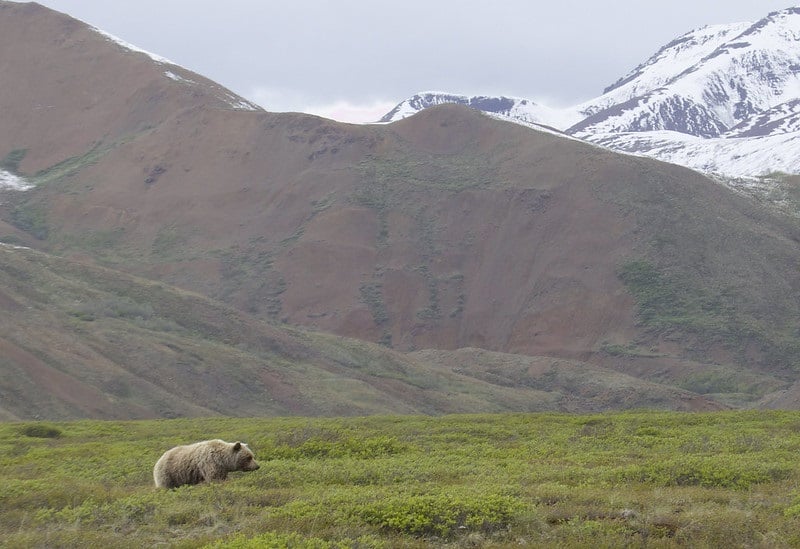
Denali National Park was first established back in 1917, and is a sprawling area of rugged semi-wilderness located 240 miles north of Anchorage. It’s home to the tallest mountain in North America, which stands at 6190 metres and is known as Mount McKinley to Westerners and as Denali to Native Americans.
However, Denali is also home to something else: 300-350 grizzly bears, spread across 4.7 million acres of land. These grizzlies roam the park alongside moose, caribou, arctic ground squirrels and dall sheep, and while they probably debate it amongst themselves, the bears are undeniably top of the food chain.
These are inland bears, with very little fish to eat, and consequently, Denali’s bears are far smaller than those of Katmai National Park (where “grizzly man” Timothy Treadwell used to hang out). 600 pounds is considered to be a large male, compared to 1200 pounds on the salmon paradise of Kodiak island.
Nor does the population reach the 700 grizzlies that Yellowstone boasts, but what Denali does have is stability: they never plummeted to the level of 150 bears like Yellowstone did in the 1970s when garbage problems were at their peak.
The bears here have a distinct yearly pattern. In spring, they stick to the valley floors and low hills, whereas in summer, they ascend to the grassier high and middle slopes. Paw prints have even been found in the snowfields of Mount Denali itself. In late summer and autumn, they descend to the valleys again, making August or September the perfect time to spot a Denali bear.
| 2 | Famous for being blond |
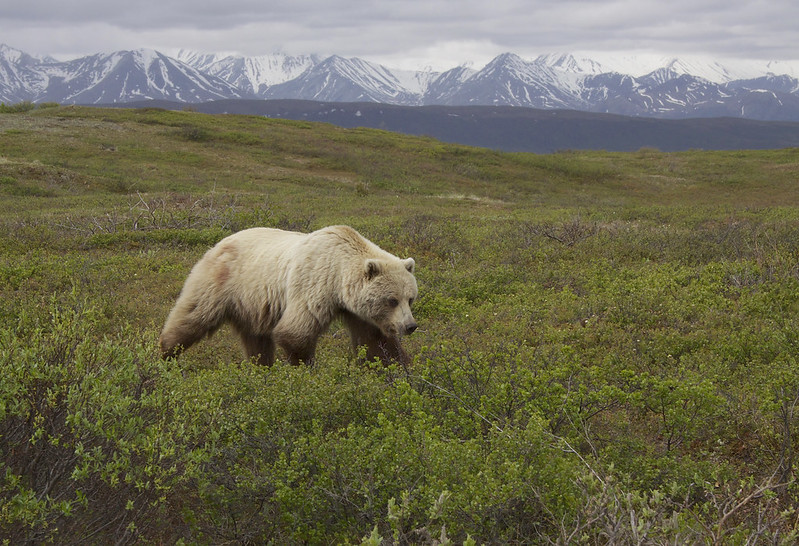
Blond grizzlies aren’t particularly unusual around the world. They’ve been spotted in Russia and Yellowstone Park alike, but Denali has a disproportionately high amount of them. Why? Nobody knows. All bears have brown, near black, and blond colour phases, activated by genetics, but there’s no unique evolutionary pressure for Denali to create blond bears. There’s plenty of snow fields where camouflaging could be beneficial, but not above and beyond other Alaska locations. It was probably a happy accident where a group of blonder than average bears happened to be the first colonisers, creating a blond gene pool.
These blond bears have even been given the nickname of Toklat bears, after Denali’s Toklat river. Some of the bears are blond all over, but others have amazing blond rings around their chests, or are blond with brown-coloured legs.
Adolph Murie spent 25 summers studying the grizzlies of Denali, and blond bears popped up repeatedly in his journals. On June 25th 1964, a photographer told him that a blond grizzly had “exploded” out of the bushes towards a spiky porcupine, and sure enough, when Murie arrived, the blond bear was rubbing at its paw anxiously. On June 6th 1965, Murie observed a blond mother and blond cub run riot on a heavily ridged mountainside, spooking 5 herds of caribou, until they finally located a bloody carcass and spent 25 minutes feeding. They probably weren’t blond after that.
| 3 | Encounters in cars are common |
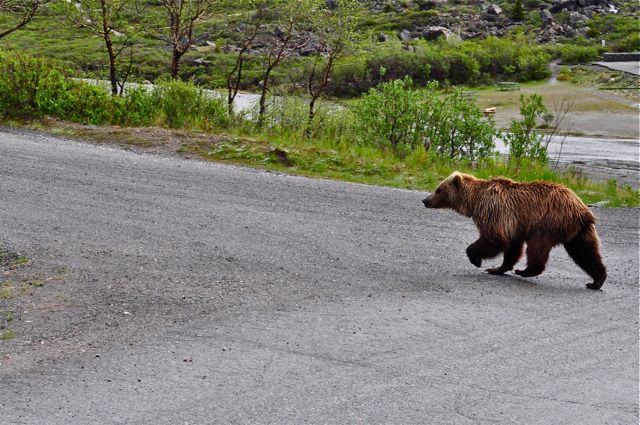
The bears of Denali are also far easier to spot compared to Banff or Katmai, because Denali is a relatively unforested national park. A large swathe consists of open tundra lowland, covered with shrubs and berry bushes. The rest is steep mountainsides, and because fully paved roads travel through the heart of the park, it’s easy to park your car and observe the uninterrupted landscape for miles around. You can scan the horizon for brown or blond dots amid the snow patches, or keep your eyes perfectly still until they register a slight movement.
Because black bears prefer forests, it’s actually easier to spot the larger grizzly in Denali National Park. The internet is packed with stories of bears devouring shrubs right by the road, creating an all-consuming temptation for drivers to stop and hug them
Bear jams are equally common. In 2015, a mother and her 2 near-adult sized cubs were awarded National Geographic’s photo of the day when they blocked the Park road, a private road open for 5 days each summer. This video shows 3 cars stuck behind a relaxed looking grizzly bear on a tricky downhill mountain road. At one point, it seems like the bear has learnt the art of politeness and is sticking to the side of the road, but the next second, he darts back across. Finally, the grizzly climbs a muddy bank between a curve, giving the cars a brief chance to escape, until they succumb to the urge to take pictures instead.
| 4 | Survives on tough, chewy roots |
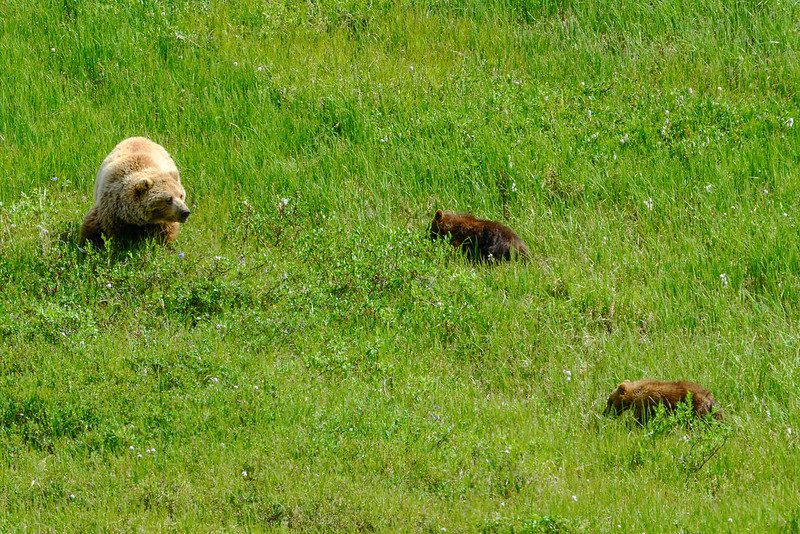
As the Denali bear first emerges from hibernation in April, there are no berries to munch on and certainly no schools of salmon to devour. Their main choice is the long, hard school of digging for the thick fleshy roots of peavine plants (Hedysarum alpinum americanum), which look like a cluster of colourful lilac flowers. For mysterious reasons, this is the only root that Denali bears dig for seriously, except for occasional rock fireweed and coltsfoot. It’s said to have the flavour of garden peas, and the peak digging season in Denali is the month of May.
To acquire the delicious peavine, the bear uses its massive muscular hump to tear into the soil, before using its entire body to pull the exposed roots free. The cubs, meanwhile, nose through the mother’s diggings to find the roots which she’s missed. Peavine is particularly common by the rivers of Denali such as the Toklat, and in the densest spots, bears can dig so relentlessly that the soils resemble a ploughed field afterwards. Some years, a patch will be completely and utterly destroyed, and the bear won’t return for 2 years, before the ecosystem recovers as if by magic.
In early June, this root-munching party suddenly stops, and the Denali bears move to new pastures: high altitude mountain slopes where they can graze on grass and sedges like an alpine cow. Half of these grasses are barely digested – the bears are merely buying time.
| 5 | Blueberry addiction (it’s a problem) |
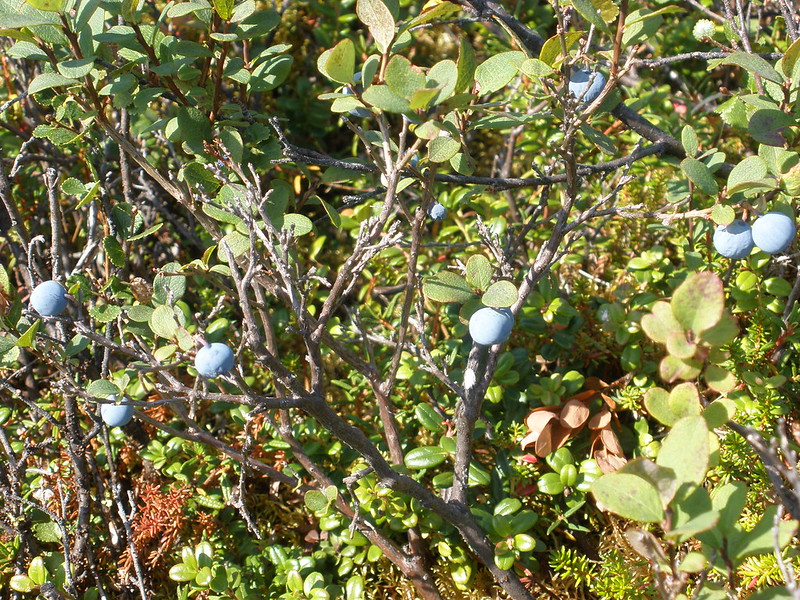
Late summer or autumn is when the party really gets started, as the bears of Denali switch focus to berries, and in particular, the common blueberry. Hikers are often shocked at the millions of blueberry plants which cover almost every inch of Denali’s lowlands. The bears have no patience whatsoever and usually start devouring the blueberries long before they ripen. Bears can spend hours in a single patch, using their prehensile lips to grip the branches and rip the berries off, making up for their lack of fingers.
Soapberries are another Denali bear favourite, a tiny red berry which grow in dozens on a single bush. During the height of its mad hyperphagic feeding season, a Denali bear can eat 200,000 soapberries (also called buffalo berries) per day. Humans hate them (hence soap-berries), but bears adore them because of their abundant amino acids. The rule of thumb is that if a distant Denali bear is bopping its head up and down, it’s snacking on blueberries, but if it’s moving its paws from side to side, then it’s probably snacking on soapberries.
Cranberries are also common in Denali, but they tend to go ignored, except in spring and early summer when other berries are scarce. Completing the “big three” is the hard, black crowberry, which are common from the lowlands to all but the highest slopes. These glossy berries measure 1/3 inch across, bigger apiece than soapberries, and have a bland taste to humans, but not to bears.
| 6 | Bear assaults from the vaults |
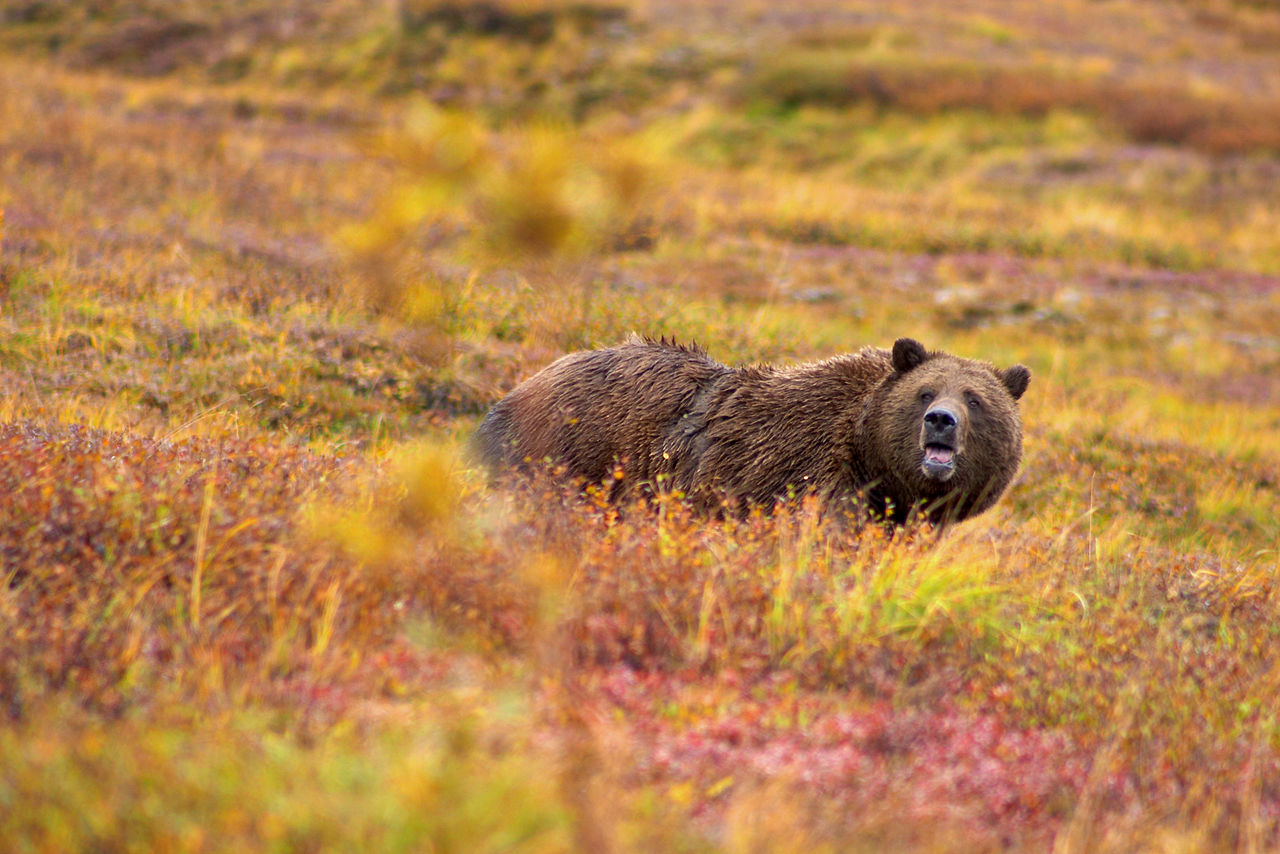
Sometimes it feels like there must be one bear hotspot on Earth where they behave just like your favourite teddy bear, but Denali isn’t that magical place. They’re the same as any bears – peaceful if you have the secret bear wisdom, but undoubtedly dangerous if you don’t.
August 4th 1961, for example, saw a totally unprovoked attack. Ecologist Napier Shelton was wandering the slopes of Igloo Mountain examining the forests, when he heard an ominous growling. Turning around, he saw a large grizzly charging out of the willow trees only 10 feet away. He was lucky that the 25 foot tree he was examining had wide, horizontal limbs extending almost to the ground, and up the tree he went.
Unfortunately, the bear managed to grab his ankle, sinking its paws deeply into his calf before slipping down again, and dragging Shelton partly with it. The bear recovered and climbed high once again, this time biting Shelton’s thigh. With his other free leg, still clutching the tree, Shelton kicked and kicked. The bear let go, and circled the tree two or three times, before deciding to leave.
Shelton stayed in the tree for half an hour before daring to climb down. He lived, but suffered deep claw wounds, and the doctor claimed to have found traces of blueberry juice in them! Lesson one – never underestimate a Denali grizzly.
| 7 | Rules and regulations |
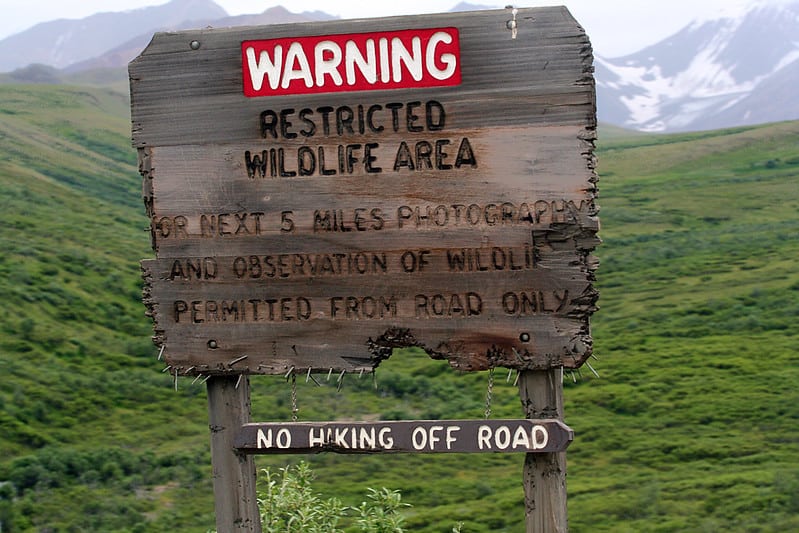
Every national park in America is allowed to make their own rules, and one of the biggest differences in Denali is that straying within 300 yards of a grizzly bear is forbidden. That’s much larger than Katmai National Park’s 25 yards, where the bears are far more habituated to people (but fortunately not the taste of them).
A big difference to Yellowstone is that bear resistant food containers are mandatory in Denali. These are unbreakable canisters made from futuristic forms of plastic, which require extremely precise motor skills to open – this prevents the bears from getting addicted to human foods and becoming “nuisance bears” who will inevitably get shot. Unlike parts of Canada, there’s no strict requirement to bring bear spray to Denali, although the NPS highly advises it.
As of February 2010, it’s now legal to bring guns into all sections of Denali, although firing them remains illegal. Beforehand, two thirds of the park were a gun free zone, and in May 2010, there was controversy when a grizzly bear charged from the thickets and was shot dead by an unsuspecting hiker wielding a .45-caliber semiautomatic pistol.
Naturally, route restrictions must always be obeyed, and like in Yellowstone, it’s common to saunter along to your favourite route from last summer and find a stark red and black sign reading “trail closed! bear in the area“. The sign continues with “We share this landscape with bears. Human activities will resume when the bear moves on”.
| 8 | More tales from the vaults |
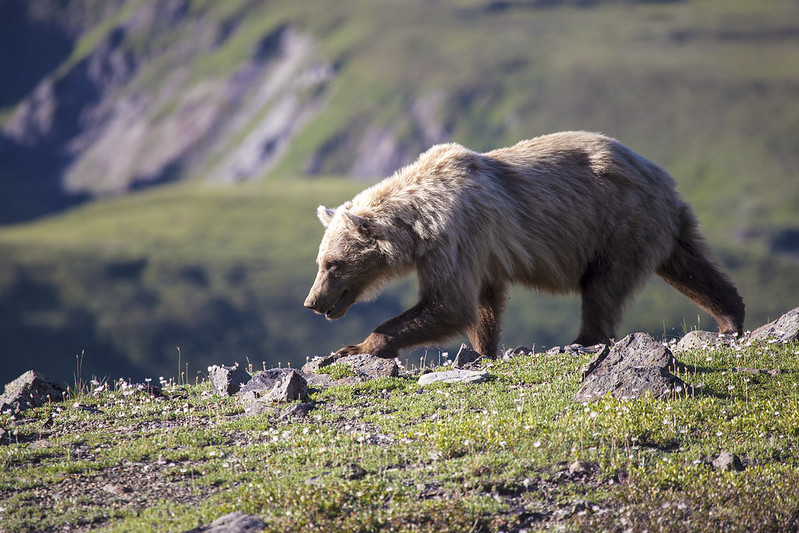
From 1922 to 1970, esteemed naturalist Adolph Murie spent 25 summers in Denali National Park observing bears, sometimes doing nothing other than watching them eat berries for hours. Murie had already pressured Yellowstone Park into halting its wolf killing program in the 1930s, and when he died in 1974, his son finished and published his manuscript, simply titled “The Grizzlies Of Mount McKinley”. It contains hundreds of obscure bear tales, and in one, a small bear unknowingly wandered towards 12 wolves on September 4th 1964, who quickly took notice and surrounded him. The bear turned to confront the alpha wolf, but was forced to spin around repeatedly as others closed in on its rear. This stand off lasted for 5 minutes, until suddenly, all 12 wolves decided to give up.
In late July 1963, Murie observed 2 bears feeding peacefully on a mountainside. They were 200 yards from a fox den, and soon, a small fox family of 3 emerged and watched the bears cautiously. The bears stayed in place all day, minding their own business, and by the afternoon, the slope was a fairytale scene of 2-3 alert foxes and 12 extremely paranoid looking arctic squirrels.
Murie rarely saw wolverines interact with bears, but one story from August 7th 1961 was particularly telling. A wolverine was wandering towards a river bar, looking very relaxed, having no idea that a 500 pound grizzly bear was ahead. When a bear came into view, the wolverine stopped dead in its tracks, span around 180 degrees, and ran like the wind, without stopping for 100 yards. The bear hadn’t even noticed.
| 9 | More vegetarian than average |

If a Denali bear experienced the taste of salmon, then he’d pack his bags and be off to Brooks Falls – no doubt about it. But compared to Katmai National Park, salmon is in very short supply in Denali. Except for sections of the Toklat river, the annual migration routes simply don’t pass through the park. Other sources of animal flesh are equally hard to come by, meaning that Denali bears are comparatively vegetarian. For example, Denali has approximately 1760 caribou, but within days of birth, they’re already speedy enough to dodge a hungry bear. The average bear snags just a couple of calves per year, and it’s a similar story for the 1800 moose in Denali. Moose mothers have even been seen goring black bears before.
Denali is packed with Dall Sheep – they’re the reason why Denali National Park was first created in 1929. They look like a soft target, but dell sheep are famous for their razor sharp “bear senses”, positioning themselves on crumbling mountainsides with supreme tactical accuracy. They can also outrun a charging bear surprisingly easily.
The only safe and reliable option for a meat-hungry Denali bear is the arctic ground squirrel, small furry mammals which cover almost every square foot of the park. It doesn’t matter how many squirrels they eat – they constantly regenerate. The bears’ strategy is to sniff them out with their supersonic sense of smell, and rip apart the soil to expose their underground dens. Sometimes they’ll just wait with their head at the entrance.
| 10 | Only one death ever |
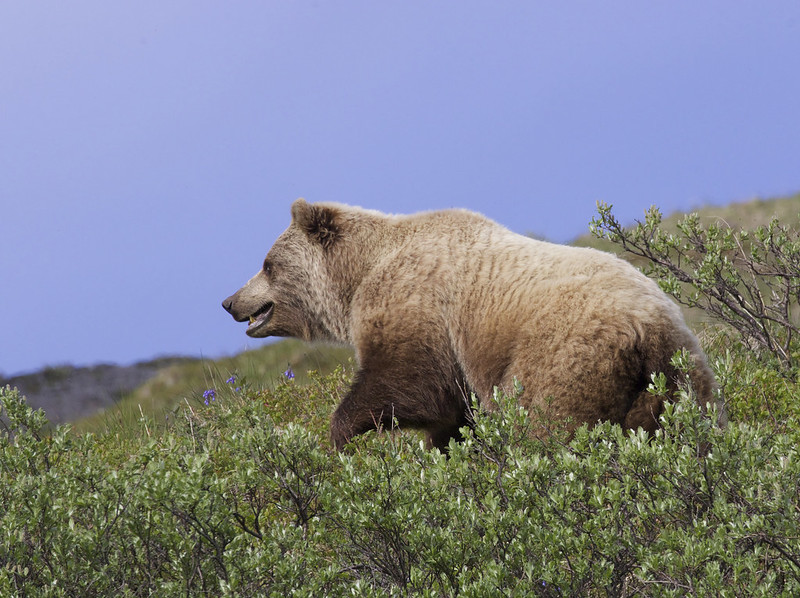
Denali National Park is “bear country” proper. The moment you step across the border, a sound effect will ring out and your place in the food chain will tumble around 10 points. Yet in the park’s 104 year history, there has only been a single death from grizzly bear activity. Like anywhere, the bears are no bloodthirsty monsters, just twitchy and unpredictable animals who fear you more than you fear them.
The park was established on February 26th 1917, and the first fatal attack took place 95 years later on August 25th 2012. Richard White, 49, was an amateur photographer wandering the banks of the Toklat River, a well known bear hub. He spotted a male grizzly feeding on willow trees innocently, and spent the next 40 minutes taking photos.
Unfortunately, he strayed to within 50 yards, much closer than the quarter of a mile recommended by Denali rangers. Later that day, fellow hikers stumbled upon his backpack, followed by scraps of torn clothing and blood. Rangers activated their helicopter, and while flying over the shores of the Toklat river, they spotted a large grizzly 150 yards below. It was sitting on human remains, guarding a “food cache” stored for later. Because the bear now had a keen taste for human flesh, a male trooper was forced to shoot it.
Images recovered from White’s camera proved the timeline of events. This was a true “fatal last photo” scenario, but luckily, the odds are still a million to 1 that you’ll survive your first summer hike in Denali (the second is debatable).

Leave a Reply